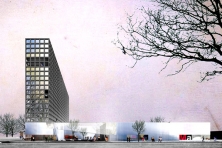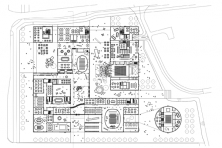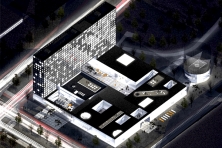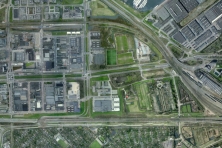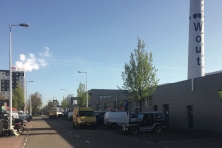MEDIA SLOBODA
Amsterdam Transformatorweg (NL) - Lauréat
DONNÉES DE L’ÉQUIPE
Représentant d’équipe: Aleksandr Zinovev (RU) – architecte
Associés: Irina Shmeleva (RU) – architecte; Konstantin Budarin (ES) – analyste et écrivain
Collaborateurs: Elmira Kakabaeva (KZ) – Relations Publiques ; Dmitriy Andreev (RU) – réalisateur
Schiewe 117b03, 3038 AL Rottderdam (NL)
+33 6 44 94 15 56 - mail@alexanderzinoviev.com
Voir la liste complète des portraits ici
Voir la page du site en anglais ici

A. Zinovev, I. Shmeleva & K. Budarin
INTERVIEW en anglais
Cliquer sur les images pour les agrandir
1. How did you form the team for the competition?
We had been working together on various architectural and urban projects since graduation from Strelka Institute in 2015. From 2017 we have lived in different countries and workd as an online office. For Europan project we also invited two collaborators - expert in education management Elmira Kakabaeva and movie director and an expert in media production Dmitriy Andreev.
2. How do you define the main issue of your project, and how did you answer on this session main topic: the place of productive activities within the city?
The main issue for the project is the lack of connectivity between different programs on the site and also between the site and the surrounding. It significantly affects the way the space is used and reduces its chances to become a productive entity and to be integrated into the future neighbourhood. Our answer to this issue is the creation of a Media Hub. The Media Hub is not a building. It is a 'temporal system' where education, working places and dwelling are connected by the web-interface and curator's programme. In the space of Media Hub, minimal city unit shrinks from the scale of separate building to the scale of specific spaces and the opportunities those spaces could offer.
3. How did this issue and the questions raised by the site mutation meet?
The brief of the competition asked to create multifunctional productive area within a tight territory, partially occupied by existing Media College building. Facing this issue, the project tends to reject the model of building as a minimal unit and proposes to create a single structure. Such approach allows to shift the focus from single building to the collection of spaces, creating borders between outdoor and indoor flexible, and involving different groups of users to the activities of the site.
4. Have you treated this issue previously? What were the reference projects that inspired yours?
Media Sloboda is a reflection on how today's technologies influence the city and its perception. Google Indoor maps is a feature for online mapping which was the main inspiration for the Media-Sloboda. Indoor maps produce a new image of a city without walls where users navigate through digital apps. Black Mirror series, especially episode "fifteen million merits" is another source of inspiration. Our vision is not that dystopian, we propose to use showcases/building's screens as mean of communication with the outer world. The issues of minimal unit, scale and density in the city - the topics we've already raised in the competition project of urban block for Kupchino district in St Petersburg. We envision a city as a collection of voids/courtyards in a continuous interconnected building.
5. Urban-architectural projects like the ones in Europan can only be implemented together with the actors through a negotiated process and in time. How did you consider this issue in your project?
Media Sloboda creates a vision where different actors receive benefits from the future common development of the site. We believe that it is a strong starting point for the project.
6. Is it the first time you have been awarded a prize at Europan? How could this help you in your professional career?
It is the first time we've participated in Europan competition. We are looking forward to working further on this project.
